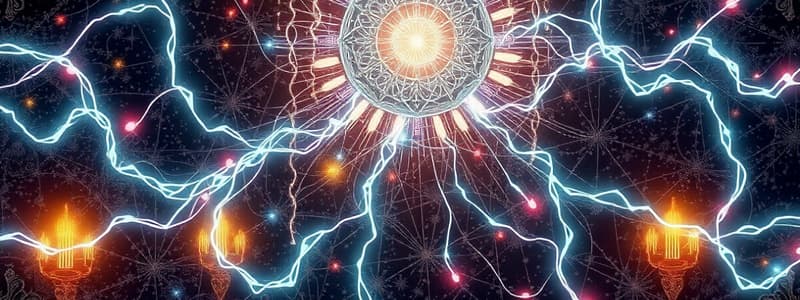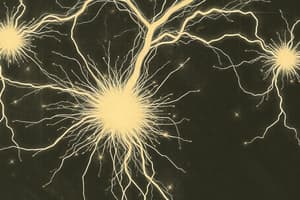Podcast
Questions and Answers
What are the SI units for the electric field vector E?
What are the SI units for the electric field vector E?
- Volts per meter (V/m)
- Newtons per coulomb (N/C) (correct)
- Joules per second (J/s)
- Amperes per square meter (A/m^2)
The electric field produced by a test charge itself is considered when determining the net electric field at a point.
The electric field produced by a test charge itself is considered when determining the net electric field at a point.
False (B)
If a negative charge is placed in an electric field pointing to the right, in which direction will the electric force on the charge be?
If a negative charge is placed in an electric field pointing to the right, in which direction will the electric force on the charge be?
left
The superposition principle states that the total electric field at a point due to a group of charges is the ______ sum of the electric fields of all the charges.
The superposition principle states that the total electric field at a point due to a group of charges is the ______ sum of the electric fields of all the charges.
Match the following charge distributions with their corresponding charge density definitions:
Match the following charge distributions with their corresponding charge density definitions:
In the context of electric fields, what is an "electric dipole"?
In the context of electric fields, what is an "electric dipole"?
Electrical conductors are materials where electrons are bound tightly to atoms and cannot move freely through the material.
Electrical conductors are materials where electrons are bound tightly to atoms and cannot move freely through the material.
What is the process called where a charged object is brought near a conductor, causing a charge separation in the conductor?
What is the process called where a charged object is brought near a conductor, causing a charge separation in the conductor?
According to Coulomb's law, the electric force between two point charges is ______ proportional to the product of the magnitudes of the charges and inversely proportional to the square of the distance between them.
According to Coulomb's law, the electric force between two point charges is ______ proportional to the product of the magnitudes of the charges and inversely proportional to the square of the distance between them.
Match the following terms with their definitions:
Match the following terms with their definitions:
Which of the following statements accurately describes electric field lines?
Which of the following statements accurately describes electric field lines?
Electric field lines begin on negative charges and terminate on positive charges.
Electric field lines begin on negative charges and terminate on positive charges.
Why can electric field lines never cross each other?
Why can electric field lines never cross each other?
In a uniform electric field, a charged particle experiences ______ acceleration if the electric force is the only force acting on it.
In a uniform electric field, a charged particle experiences ______ acceleration if the electric force is the only force acting on it.
Match the description with the respective charge and the effect on direction of the force relative to the field.
Match the description with the respective charge and the effect on direction of the force relative to the field.
What is conserved when an object is charged by rubbing?
What is conserved when an object is charged by rubbing?
The electric force between two charged objects is independent of the gravitational force between them.
The electric force between two charged objects is independent of the gravitational force between them.
What is the name given to the smallest unit of free charge known in nature, and what is its magnitude?
What is the name given to the smallest unit of free charge known in nature, and what is its magnitude?
The electric field is defined as the electric ______ on a test charge per unit charge.
The electric field is defined as the electric ______ on a test charge per unit charge.
Match:
Match:
Which of the following components are correct for calculating the net electric field vector?
Which of the following components are correct for calculating the net electric field vector?
Semiconductors are materials known for their ability to be perfect electrical conductors
Semiconductors are materials known for their ability to be perfect electrical conductors
Describe two important things to remember when using coulombs law
Describe two important things to remember when using coulombs law
The electrical force of an electron and proton force has negligably ______ when compared with the electric force
The electrical force of an electron and proton force has negligably ______ when compared with the electric force
Match the charge of the elementary particles:
Match the charge of the elementary particles:
What is a point used to visualize electric force called?
What is a point used to visualize electric force called?
More electrical lines appear on surfaces with weaker forces
More electrical lines appear on surfaces with weaker forces
Describe electrical properties of Semiconductors
Describe electrical properties of Semiconductors
It is said that the electric ______ is always conserved in an isolated system
It is said that the electric ______ is always conserved in an isolated system
Match the given value with the given force
Match the given value with the given force
Flashcards
Electric Field (E)
Electric Field (E)
The electric force per unit positive charge, measured in newtons per coulomb (N/C).
Particle in a Field Model (Electric)
Particle in a Field Model (Electric)
A model where charged particles interact with electric fields, experiencing a force (F = qE).
Point Charge
Point Charge
A particle with zero size and a single electric charge.
Conservation of Electric Charge
Conservation of Electric Charge
Signup and view all the flashcards
Charging by Rubbing
Charging by Rubbing
Signup and view all the flashcards
Charging by Induction
Charging by Induction
Signup and view all the flashcards
Electrical Conductors
Electrical Conductors
Signup and view all the flashcards
Electrical Insulators
Electrical Insulators
Signup and view all the flashcards
Coulomb's Law
Coulomb's Law
Signup and view all the flashcards
Coulomb Constant (k)
Coulomb Constant (k)
Signup and view all the flashcards
Elementary Charge (e)
Elementary Charge (e)
Signup and view all the flashcards
Quantized Charge
Quantized Charge
Signup and view all the flashcards
Electric forces
Electric forces
Signup and view all the flashcards
Superposition Principle (Electric Fields)
Superposition Principle (Electric Fields)
Signup and view all the flashcards
Electric Field due to Multiple Charges
Electric Field due to Multiple Charges
Signup and view all the flashcards
Electric Dipole
Electric Dipole
Signup and view all the flashcards
Uniform Electric Field
Uniform Electric Field
Signup and view all the flashcards
Electric Field Lines
Electric Field Lines
Signup and view all the flashcards
Semiconductors
Semiconductors
Signup and view all the flashcards
Uniform Electric Field
Uniform Electric Field
Signup and view all the flashcards
Study Notes
Electric Fields
- The electric field vector (E) has SI units of newtons per coulomb (N/C).
- The direction of E is the direction of the electric force on a positive test charge.
- E exists at a point if a test charge at that point experiences an electric force.
- The electric force on a charge q in an electric field E is given by F = qE.
- If q is positive, F and E are in the same direction; if q is negative, they are in opposite directions.
- To determine the direction of an electric field, a positive test charge is used.
- To calculate the electric field created by a point charge q at a distance r: E = k(q/r^2) r^, where r^ is a unit vector directed from q to the point.
- The total electric field at a point due to a group of source charges is the vector sum of the electric fields of all the charges: E = k Σ (qi/ri^2) ri^ where ri is the distance from qi to the point P and ri^ is a unit vector directed from qi toward P.
Charging Objects by Induction
- Electrical conductors are materials in which some electrons are free electrons, not bound to atoms, and can move relatively freely through the material.
- Electrical insulators are materials in which all electrons are bound to atoms and cannot move freely through the material.
- Semiconductors' electrical properties are somewhere between those of insulators and conductors.
- Electrical properties of semiconductors can be changed over many orders of magnitude by adding controlled amounts of certain atoms.
- To charge a conductor by induction, bring a charged object near it, causing electrons to redistribute.
- The side of the sphere near the rod has an effective positive charge because of the diminished number of electrons.
- A conducting wire connects the sphere to the Earth.
- Since electrons are strongly repelled by the presence of the negative charge in the rod that they move out of the sphere through the wire and into the earth.
- The symbol at the end of the wire indicates that the wire is connected to ground, which means a reservoir.
- If the wire to ground is then removed, the conducting sphere contains an excess of induced positive charge.
- When the rubber rod is removed from the vicinity of the sphere, this induced positive charge remains on the ungrounded sphere.
- Charging an object by induction requires no contact with the object inducing the charge.
- In most neutral molecules, the center of positive charge coincides with the center of negative charge.
- In the presence of a charged object, however, these centers inside each molecule in an insulator may shift slightly, resulting in more positive charge on one side of the molecule than on the other.
Properties of Electric Charges
- When materials behave in this way, they are said to be electrified or to have become electrically charged.
- There are two kinds of electric charges: positive and negative.
- Electrons are identified as having negative charge and protons are positively charged.
- Charges of the same sign repel one another, and charges with opposite signs attract one another.
- Electric charge is always conserved in an isolated system.
- When one object is rubbed against another, charge is not created in the process.
- The electrified state is due to a transfer of charge from one object to the other.
- One object gains some amount of negative charge while the other gains an equal amount of positive charge.
- Negatively charged rubber rod suspended by a string is attracted to a positively charged glass rod
- Negatively charged rubber rod is repelled by negatively charged rubber rod.
Coulomb's Law
- Electric force is sometimes called the electrostatics force.
- From experiments, scientists found that the magnitude of the electric force (sometimes called the Coulomb force) between two point charges is given by Coulomb's law: F = k|(q1q2)|/r^2.
- k is Coulomb's constant, equal to 8.9876 x 109 N⋅m2/C2.
- The SI unit of charge is the coulomb (C).
- Coulomb's constant is also written as k = 1/(4πε0).
- ε0 is the permittivity of free space, equal to 8.8542 x 10-12 C2/N⋅m2.
- The smallest unit of free charge e known in nature has a magnitude of 1.60218 x 10-19 C.
- The electric force is a vector quantity and must be treated accordingly.
- Coulomb's law in vector form: F12 = k (q1q2/r^2) r^12 where r^12 is a unit vector directed from q2 toward q1 as shown in Figure 23.6a
- The force exerted by q1 on q2 is equal in magnitude to the force exerted by q2 on q1 and in the opposite direction.
Studying That Suits You
Use AI to generate personalized quizzes and flashcards to suit your learning preferences.




